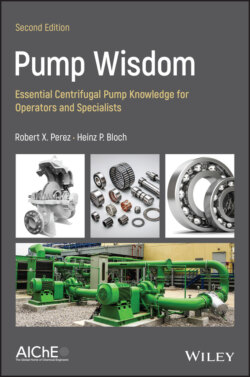Читать книгу Pump Wisdom - Robert X. Perez - Страница 18
Recirculation and Cavitation
ОглавлениеRecirculation is a flow reversal near either the inlet or discharge of a centrifugal pump. This flow reversal produces cavitation‐erosion damage that starts on the high‐pressure side of an impeller vane and proceeds through the metal to the low‐pressure side [5].
Pump‐internal recirculation can cause surging and cavitation even when the available net positive suction head (NPSH a) exceeds the manufacture's published NPSH required (NPSHr ) by considerable margins. Also, extensive damage to the pressure side of impeller vanes has been observed in pumps operating at reduced flow rates. These are the obvious results of recirculation; however, more subtle symptoms and operational difficulties have been identified in pumps operating in the recirculation zone.
Figure 1.8 A multistage centrifugal process pump.
Figure 1.9 Direction and magnitude of fluid forces change at different flows.
Source: World Pumps, February 2010, pp. 19.
Symptoms of discharge recirculation are the following:
Cavitation damage to the pressure side of the vane at the discharge
Axial movement of the shaft, sometimes accompanied by damage to the thrust bearing
Cracking or failure of the impeller shrouds at the discharge
Shaft failure on the outboard end of double‐suction and multistage pumps
Cavitation damage to the casing tongue (see Chapter 11) or diffuser vanes
Symptoms of suction recirculation are the following:
Cavitation damage to the pressure side of the vanes at the inlet
Cavitation damage to the stationary vanes in the suction
Random crackling noise in the suction; this contrasts with the steady crackling noise caused by inadequate net positive suction head
Surging of the suction flow
A quick‐reference illustration was provided by Warren Fraser Figure 1.10. We should note that recirculation and the attendant failure risks are low in pumps delivering 2500 gpm or less at heads up to 150 ft. In those pumps, energy levels may not be high enough even if the pump operates in the recirculation zone. As a general rule for such pumps, minimum flow can be set at 50% of recirculation flow for continuous operation and 25% of recirculation flow for intermittent operation [6].
Figure 1.10 Where and why impeller vanes get damaged.
Source: Fraser [5].
